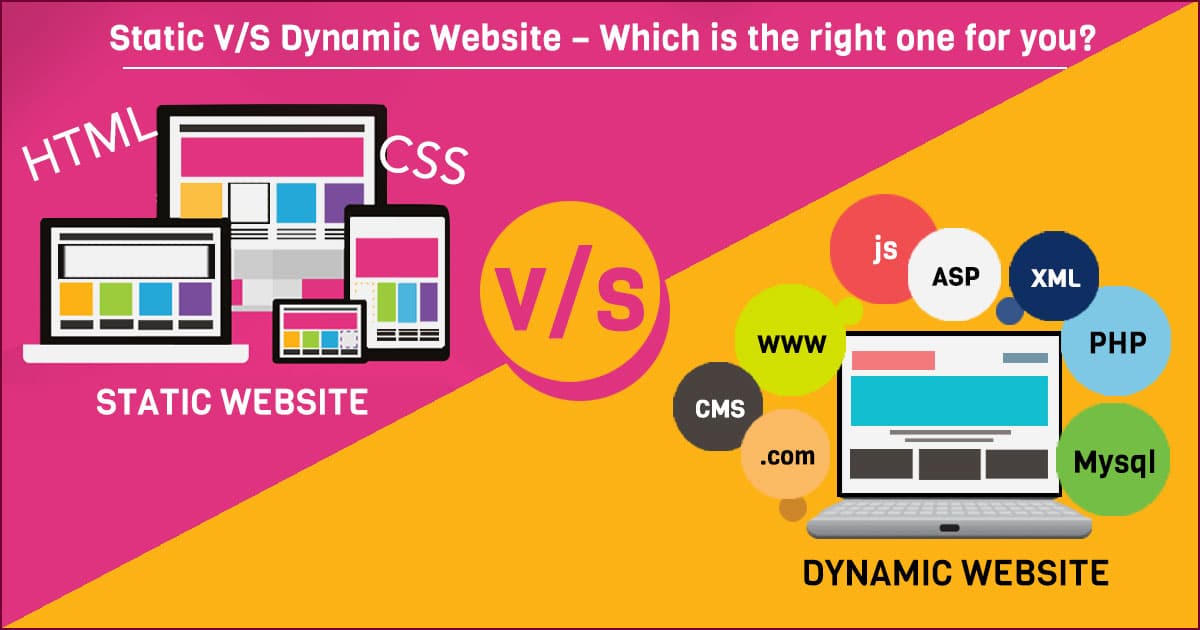Pros & Cons of Dynamic and Static Site
Nov. 12, 2022 · 6 min read
Websites can be classified as either static or dynamic. Static websites, which are often made entirely of HTML, are fixed and show the same content to every user. A dynamic website, on the other hand, uses advanced programming and databases in addition to HTML to display different materials and allow user interaction. As you can see, creating static websites is simpler than creating dynamic ones. However, this does not mean that static sites are better than dynamic sites (and vice versa).

In this article, we will explore the pros and cons of Dynamic and Static sites. And hopefully, through reading this guide, you will learn to distinguish between dynamic and static websites and decide which of the two is right for you. Without further ado, let us begin with dynamic websites.
Dynamic Website
Dynamic sites are websites that change content or layout upon request to the server. It utilizes server-side and client-side scripting, to dynamically create a webpage when a user visits the page. It also uses a database to store and manage user information/data. Simply put, users can interact with it and a page’s content changes depending on user inputs.
Although dynamic sites are extremely powerful they are also complex. However, along with this complexity are numerous advantages and disadvantages.
Pros and Cons of dynamic website
Pros
- Provides a better User Experience : A dynamic website is highly user-friendly and enables users to make modifications to the website as needed. These websites allow visitors to submit comments or responses based on their interactions with the website. This enables the developers to get immediate feedback on their work, which they can then improve. It is possible to create easy navigation, add and upgrade functionalities, and so on fast and effectively, all of which will enhance the overall experience.
- Easier Updates : The main benefit of a dynamic website is that it is simple to change according to the requirements of the website owner. A single update to the template file will change the design of all the pages that use that specific file, thus modifying a dynamic website does not need advanced technical skills. It can be swiftly modified to adapt to different screen sizes, which was not feasible with a static website.
- Easily Manageable : Dynamic websites make utilize scripting languages that interact with the information in the databases, making it simple to implement site-wide updates without having to do it one at a time.
- More personalized Browsing : The ability to give users a personalized browsing experience is one of the most important benefits of having a dynamic website. This includes content and product recommendations, recently viewed products, and content based on location and demographic which helps keep visitors to your site.
Cons
- Slower Processing : As mentioned, dynamic websites offer a better user experience compared to static websites. Web pages are generated as per the user’s input which exerts a major toll on server resources. As a result, the server has bottlenecks, and end users have delayed response times.
- Costly : Compared to creating a static website, creating a dynamic website might be more difficult. As a result, developing a dynamic website will be more expensive and need significant resources to develop and maintain.
Now we know what are the pros and cons of a dynamic website. Next, we gonna tackle is about static websites.
Quick recap what is a static website

A static website is created using CSS & HTML used to build webpages. It is made up of a collection of coded files that are used to represent various physical pages on the site. These websites are simple and quick to create. A static website resembles an online brochure, complete with forms and hyperlinks that allow potential buyers to explore different pages on the screen. A static web site’s pages, once created, will remain static and cannot be updated without coding skills. That is, if the business owner wishes to update specific information on the static website, he must hire a skilled developer to do so.
Pros and Cons of static website
Pros
- Time saving : One of the most significant benefits of a static website is its quick development time. A static website is easier to create than a dynamic one.
- Cost-Effective : A static website, as opposed to a dynamic website, is relatively inexpensive to create. So entrepreneurs on a tight budget would undoubtedly choose this alternative. You may buy dedicated servers at a lower cost for static websites.
- Easy Indexing : Because it is simply a collection of coded HTML or CSS files, search engines such as Google can easily index it.
- Fast Transferring : Because static websites do not have complex structures like dynamic websites, they can be easily transferred from server to client without requiring lengthy processing time.
Cons
- Limited Functionality : Because static websites do not have complex structures like dynamic websites, they can be easily transferred from server to client without requiring lengthy processing time.
- Difficulty in changing and updating information : It takes time and effort to edit and refresh the material on a static website. To finish the operation, a technical expert will be necessary because every HTML file must be altered individually even to make minor adjustments to the web pages.
- No Apt for the long run : To stay up to date with the latest information, any online business must make several changes and updates. To make changes live on a static website, each file must be changed multiple times.
Summary
In the early years of web development, websites were mainly static or composed of HTML pages. However, along with the rapid improvements in technology, websites have also become dynamic and complex. Static and Dynamic sites both have their advantages and disadvantages. To sum up, static sites works well for small websites that does not need to be dynamic (like blogs). Anything beyond that, should opt to build a dynamic website.
To have further details regarding on dynamic and static websites, please check this article What is dynamic and static website (Sagnoy & Dayuday, 2022)